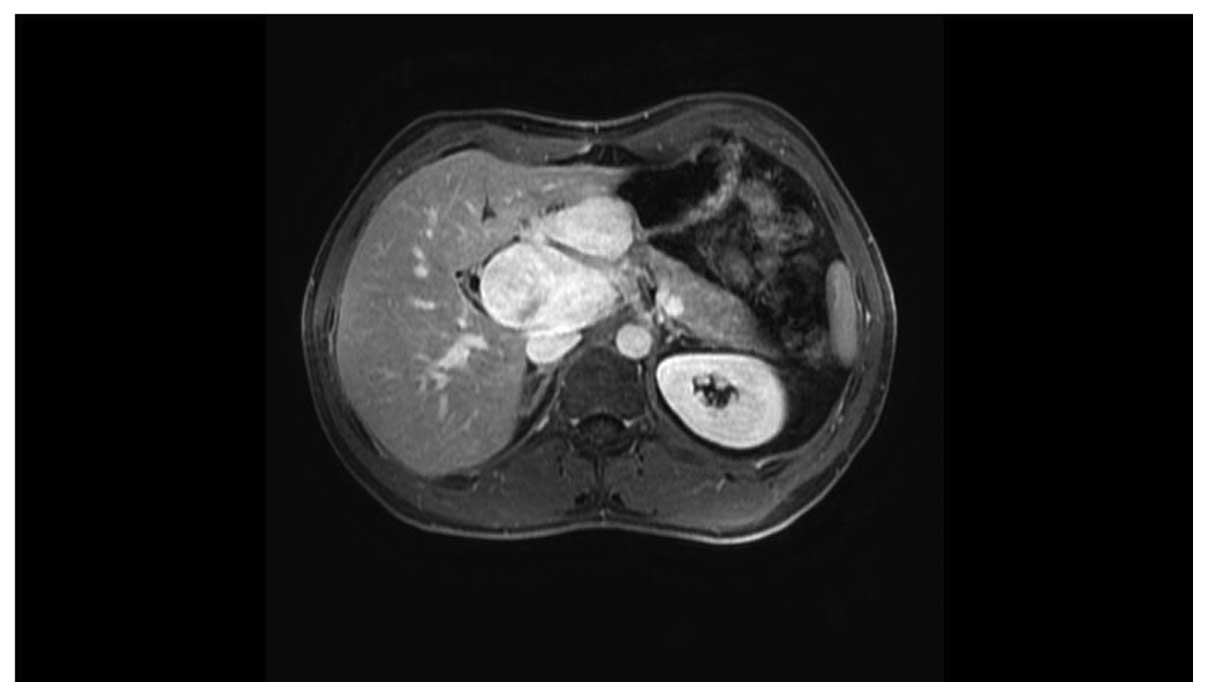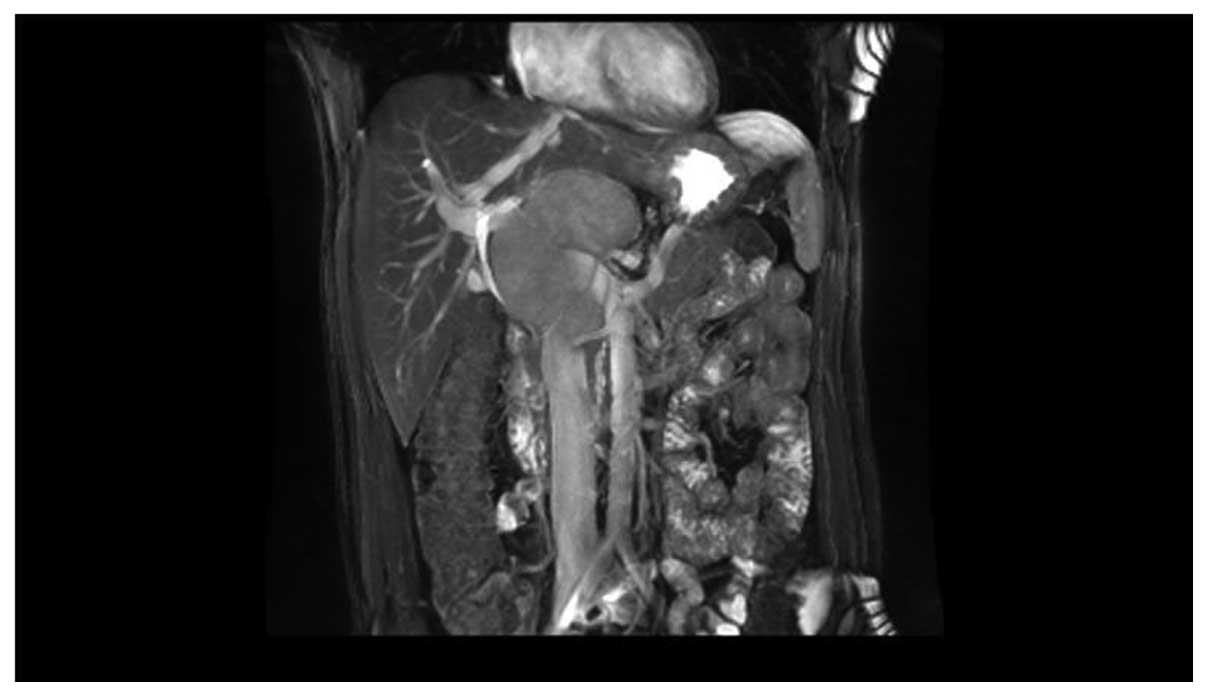Pancreatic schwannoma: A case report and review of the literature
- Authors:
- Published online on: September 30, 2014 https://doi.org/10.3892/ol.2014.2578
- Pages: 2741-2743
Abstract
Introduction
Schwannomas or neurilemmomas are rare neoplasms that typically occur in the peripheral nerve sheath of the extremities. However, visceral localization of these tumors, specifically pancreatic schwannomas that arise from either sympathetic or parasympathetic fibers of the pancreas, is particularly rare (1). Pancreatic schwannomas affect adults with an equal gender distribution. In the majority of cases, these tumors are well-defined, encapsulated solid masses with hemorrhage or cystic degeneration, calcification, hyalinization and xanthomatous infiltration (1–3). Imaging findings of pancreatic schwannomas with cystic degeneration may present a cystic pancreatic lesion. The present study reports a patient with a pancreatic head tumor presenting with weight loss and abdominal pain. The pancreatic head tumor was diagnosed as a schwannoma, which was considered to be a rare case with an unusual localization. The patient provided written informed consent.
Case report
A 30-year-old male was admitted to the Ankara Oncology Research and Education Hospital (Ankara, Turkey) presenting with weight loss and abdominal pain. The patient exhibited no other systemic symptoms. On physical examination, a tender mass in the epigastrium was palpated. The laboratory examination results, including hemoglobin, liver function tests, amylase and tumor marker levels (carbohydrate antigen 19-9 and carcinoembryonic antigen) were in the normal ranges.
Abdominal ultrasonography revealed a hypoechoic mass measuring 7.6×3 cm in the pancreatic head. Upper abdominal computed tomography (CT) showed a hypodense mass measuring 10×7 cm arising from the head of the pancreas. Upper abdominal T1-weighted dynamic magnetic resonance imaging (MRI) revealed a hypointense, bilobular, contoured, encapsulated mass measuring 8.7×9 cm, which exhibited cystic components arising from the head and the uncinate process of the pancreas and portal hilus; the mass encased the superior mesenteric artery and laterally replaced the portal vein. Following the administration of gadolinium, an early and persistent enhanced signal was noted in the T2-weighted fat saturation sequences (Figs. 1 and 2), and the lesion was markedly hyperintense (Figs. 3 and 4). Based on the patient’s history, and the clinical and imaging findings, an ultrasonography-guided Tru-cut needle (WestCott 16G, Beckton Dickinson, Downers Grove, IL, USA) biopsy was performed and pathological evaluation showed characteristic spindle cells and strong positive immunoperoxidase staining for S-100 protein, which was consistent with schwannoma. Therefore, a duodenopancreatectomy was performed.
Discussion
Schwannoma or neurilemmoma are rare, well-defined, benign encapsulated, slow growing tumors arising from Schwann cells that encase the peripheral nerves (1–3). Extracranial schwannomas typically occur in the extremities, however, are also found in the trunk, head and neck, pelvis and rectum (4–10). Intra-abdominal, retroperitoneal and particularly intra-pancreatic presentation of schwannoma is extremely rare (9,10). The number of cases of schwannoma located in the small bowels, bile ducts, pelvis and sacrum are currently limited (6,11) with <26 cases of pancreatic schwannoma reported in the literature to date. These tumors vary considerably in size, ranging from 1.5 to 20.0 cm in diameter and the majority of the tumors are located in the head (38%) and body (25%) of the pancreas. Half of the reported schwannomas are cystic and 5% of schwannomas are associated with neurofibromatosis type 1.
Typical CT findings of pancreatic schwannomas are similar to non-pancreatic schwannomas and demonstrate a well-defined, encapsulated, hypointense solid mass with hemorrhage or cystic degeneration, calcification or hyalinization (1–3,12). Cystic formation may mimic cystic pancreatic lesions, such as neuroendocrine tumors, cystadenoma, cystadenocarcinoma, intraductal papillary mucinous tumor, lymphangiomas and pancreatic pseudocysts (13).
Characteristic MRI findings of these tumors include typical encapsulation, hypointensity on T1-weighted images and hyperintensity on T2-weighted images (13). MRI may also differentiate pancreatic schwannoma from adenocarcinoma due to the characteristic hyperintensity on T2-weighted images and marked enhancement of the lesion in comparison with the remainder of the pancreas.
In the present case, the tumor was an encapsulated pancreatic mass with cystic components. Although CT and MRI may aid in the differential diagnosis, a definitive diagnosis of pancreatic schwannoma requires histopathological examination. Microscopically, schwannomas are strongly positive for S-100 protein, vimentin and cluster of differentiation 56, however, are negative for other tumor markers (14). Surgical excision with a close follow-up and surveillance remain the mainstay treatment method for pancreatic schwannomas.
In conclusion, the diagnosis of pancreatic schwannomas, although they are rare, must be considered in the differential diagnosis of well-defined, encapsulated cystic lesions of the pancreas.













